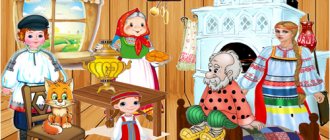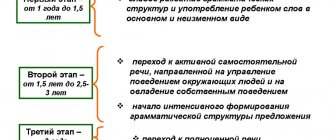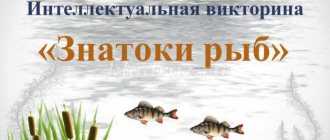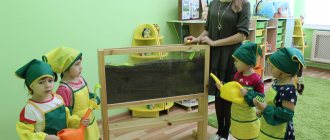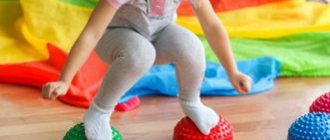Didactic games and exercises for the formation of the morphological structure of speech
Didactic games and exercises on the formation of the nominative plural.
1. Game “One - many”.
Goal: to teach children to form nominative plural nouns.
Visual material: subject pictures – words in singular and plural.
Progress of the game: children were shown a picture depicting one object and were asked to find a picture depicting the same object, but in larger quantities.
Speech material:
— I have a red ball. - And I have red balls (child).
2. Game “What grows in the forest.”
Purpose: formation of the plural form of a noun with the ending -ы.
Visual material: subject pictures and plot picture.
Progress of the game: the plot picture “Forest” was hung on the board, the children looked at the picture, and the experimenter gradually hung cards of singular objects around this picture (oak, pine, birch, mushroom, flower, bush, berry).
Speech material:
— Is there one oak tree growing in the forest? (Oak trees grow in the forest); — Is there only one pine tree growing in the forest? — Is there one mushroom growing in the forest?
3. Game “Who has a similar picture?”
Goal: formation of plural forms of nouns ending in -ya.
Visual material: subject pictures.
Progress of the game: children were given pictures depicting an object in the plural, the experimenter raised his picture and asked the children who had a similar one.
— There is a chair in my picture. Who has the same one?
4. Game "Change the word."
Goal: to consolidate knowledge of the plural form of the nominative case of nouns with different endings.
Equipment: ball.
Progress of the game: the child was named words in the singular and after catching the ball, he must name the word in the plural.
Didactic games and exercises on the formation of the singular genitive case with prepositions.
1. Game “Which tree did the leaf fall from?”
Goal: to consolidate the names of trees, the genitive singular form with the preposition S.
Visual material: subject pictures.
Progress of the game: cards with tree leaves were distributed to the children. Children must determine which tree leaves they have and name the tree: “My leaf fell from a maple tree.”
2. Game "Scrabble".
Purpose: to consolidate the body parts of animals, and the formation of genitive case forms with the preposition U.
Visual material: subject pictures.
Progress of the game: children were given pictures of animals and asked questions.
Speech material:
- Who has a big trunk? - Who has a fluffy tail? -Who has a pointed nose? - Who has long ears? -Who has hooves?
3. We play the fairy tale “Kolobok”.
Purpose: formation of the genitive case form with the preposition from.
Visual material: subject pictures of heroes from the fairy tale “Kolobok”.
Progress of the game: the children were read the fairy tale “Kolobok”, then the fairy tale was read a second time, but with gaps, and the children must continue (from grandmother, from grandfather, from the wolf, from the hare, from the bear).
Didactic games and exercises for the formation of the genitive plural.
1. Didactic game “Choose a rhyme.”
Goal: to develop the ability to form the genitive plural form of nouns.
Visual material: subject pictures.
Progress of the game: a comic poem was read to the children:
I give you my word of honor, Yesterday at half past five I saw two pigs without hats and boots.
“You and I can also make up funny jokes.” I will start, and you continue (the children are shown pictures while reading the poem, which were spoken out in advance).
Speech material:
We give our word of honor: Yesterday at half past five We saw two magpies without ... (boots) and ... (socks), And puppies without ... (slippers), And titmice without ... (mittens).
2. Game exercise “Preparing for the winter.”
Goal: to consolidate the topic “Vegetables and fruits”, to develop the ability to form the plural of the genitive case of nouns.
Visual material: subject pictures.
Progress of the game: the children were told that in the fall, preparations of vegetables and fruits are made for the winter. These are juices, jams, jams, salads, compotes and jams. Afterwards, they were given pictures of vegetables and fruits, and were asked to make suggestions on what they would cook from what was shown in their pictures.
3. Game exercise “Guess what’s missing?”
Goal: to consolidate the ability to form the plural of genitive nouns.
Visual material: subject pictures.
Progress of the game: four pictures with plural objects were hung on the board, then two pictures were removed, and the children were asked: “What is missing?” Pictures were selected with different endings.
Didactic games and exercises for the formation of the dative case singular and plural.
1. Game exercise “Who needs what for work”
Goal: to consolidate the topic “Professions”, to master the dative case in the singular and plural.
Visual material: subject pictures.
a) Progress of the game: children were given pictures showing a teacher without a pointer, a painter without a brush, a hairdresser without scissors, etc. Then each child must stand up, show his picture and say: “I have a teacher without a pointer, he needs to be given a pointer,” etc.
b) Progress of the game: pictures with girls, bears, dogs, etc. were hung on the board, and pictures with objects (book, candy, ball, etc.) were given to the children. Each child must come up with his own picture and choose who he will give what.
Speech material:
- I'll give candy to the girls; - I'll give the book to the bears.
2. Game "Guests".
Goal: consolidation of the topic “Wild Animals”, mastering the dative case.
Visual material: object pictures and soft toys.
Progress of the game: children sat around the table, each child had toys, the experimenter had a bunny, pictures with treats were laid out on the table. Children were asked to choose from a picture for their animal:
- I'll give the nuts to the squirrel; - I'll give honey to the bear.
Didactic games for the formation of the accusative case.
1. Didactic game “Who is the most observant.”
Goal: to develop children's attention, memory, and everyday vocabulary.
Progress of the game: children must look at what is around and name more objects in complete sentences. The first child said in the singular, and the second repeated in the plural.
Speech material:
- I see a table, a window, a chair... - I see tables, windows, chairs...
2. Didactic game “Change and say correctly.”
Goal: to teach children to listen carefully and find mistakes.
Progress of the game: children were asked questions and given answers in the initial form, the child had to give the answer in the correct version.
Speech material:
- Who do I love? What? (mother, Motherland, cat); - Value what? (work, care, friendship); - Take care of what? (book, toy, trees, birds); - Remember what? (fairy tale, song, riddle, poem).
Didactic games to clarify the form of the instrumental case.
1. Didactic game “Who defends themselves with what?”
Goal: to consolidate the topic “Animals and Birds”, mastering the instrumental case.
Visual material: subject pictures.
Progress of the game: children looked at pictures of animals and answered the questions: who is defending themselves with what?
Speech material:
- How does a dog protect itself? (elephant, deer, hedgehog, goose, cat).
2. Game “What are they doing with what?”
Goal: expand your vocabulary, teach how to form phrases and agree a verb with a noun, and learn the instrumental plural form.
Visual material: subject pictures.
Progress of the game: children were given object pictures depicting tools in the plural: saws, axes, shovels, needles, knives, scissors, etc., children had to make up phrases answering the question “What do they saw with (dig, sew, cut and etc.)?
3. Games “When does this happen?”, “Who is after whom?”.
Purpose: to consolidate the form of the instrumental case.
a) Visual material: subject pictures.
Progress of the game: pictures with the seasons were hung randomly on the board, and the children were asked the question “What comes after what?”
b) Progress of the game: children were divided into two teams. The drivers stood in front of the team, with their backs to the other children. Their task is to remember and say who is behind whom. The correct answer is rewarded with a chip.
Games to clarify the form of the prepositional case.
1. Game exercise “Caring”.
Goal: teach children to make sentences based on pictures. Mastering the form of the prepositional case.
Visual material: story pictures.
Progress of the game: children were given pictures depicting children caring for animals and plants. The question was asked: “Who (what) do children care about?”
2. Game exercise “Help the animals find their home.”
Goal: consolidation of knowledge about the home of animals, clarification of the prepositional case.
Visual material: subject pictures.
Progress of the game: pictures with animals' homes were hung on the board, and pictures with animals were hung under the houses in a mixed up form. Children were encouraged to help animals find their home. The answer is given in a complete sentence.
